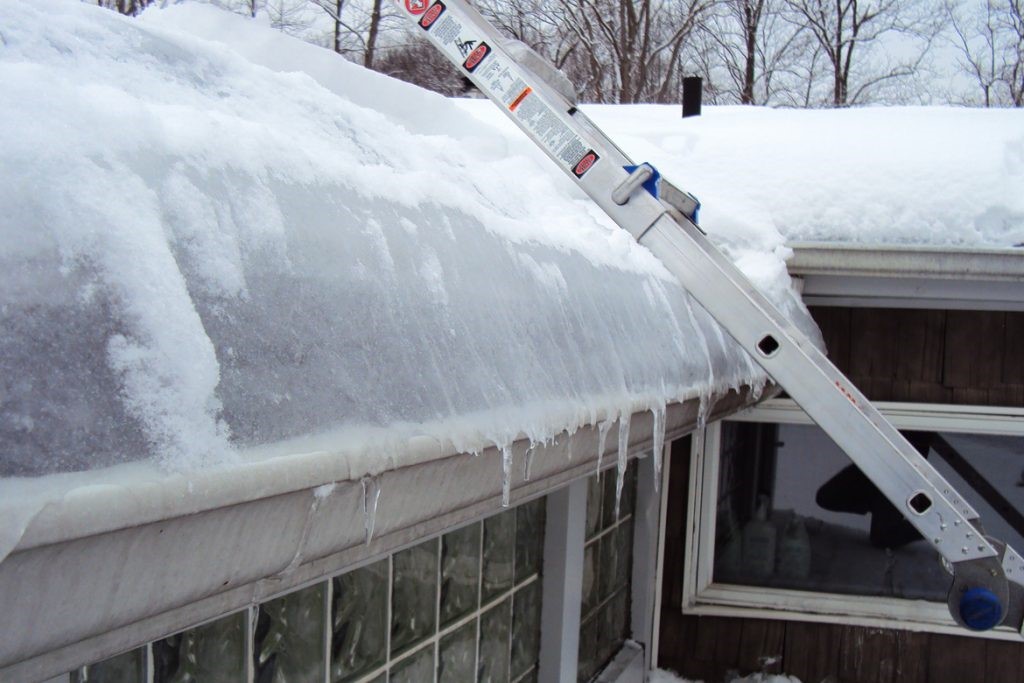
5 Ways to Get Rid of Ice Dams
Here in Colorado, winter roof care isn’t something you can ignore. Doing so inevitably spells trouble for your roof and your home, and it increases the likelihood that you’ll need to pay for some professional help with your roofing in the winter, and that could be costly.
Below-freezing temperatures, snow, freezing rain, wind, and other strong weather events can take their toll on your roof, which is why it’s so important to take the proper steps to maintain your roof in winter.
Some of the most harmful winter roofing issues are ice dams on your roof. Let’s dig into what an ice dam is and some winter roofing tips to get rid of them.
What is an ice dam?
An ice dam is a buildup of ice along the edge of your roof. It happens when water runs down your roof to your gutters and then freezes, causing a buildup of ice that continues to increase in size until it can melt off.
But why does this happen? To get more specific, ice dams occur when there is not enough insulation and also poor air infiltration between the attic and the living space. This causes warm air to rise and go into the attic. The warm air in the attic melts the snow on the roof deck and the melted snow begins to run off the roof. Once the water hits the soffit area it begins to freeze. The water freezes over the soffit because the warm air that was under the roof is no longer there and the cold air under the soffit begins to freeze the melted snow.
The leading cause of ice dams is poor attic ventilation, as warm air escapes your home into your attic, melting snow, and the cold temperatures outside freeze the water before it can drain away. Another issue that creates ice dams is clogged gutters.
Ice dams are not only bad for your gutters, but they are bad for your roof and your home in general. They can damage shingles and loosen them, pull your gutters away, and create water leaks that can damage your home.
Ice dams can happen due to several situations:
5 Ways to Get Rid of Ice Dams
1. Evaluate and Add Insulation
A long-term fix for preventing ice dams is to add more insulation to your attic to help prevent warm air from escaping through it. Add more insulation to the floor of your attic perpendicular to the existing attic floor insulation, and if possible, insulate right under the roof in between your rafters. The insulation prevents heat loss from the interior of your home.
2. Evaluate and Increase Ventilation
A key point to remember when considering ice dams is that the temperature should be the same inside the attic as it is on the exterior of the home if the attic is insulated. Good airflow from under the eaves or soffit area along the underside of the roof and out through the roof vents is essential. The insulation prevents heat loss from the interior of the home. The venting allows the attic air to stay cold enough to prevent or minimize the freeze/thaw cycle on the roof.
Position a box fan in your attic to direct cool air toward the area where an ice dam has formed. This will help freeze the water and keep it from leaking into your house or flowing down to make the ice dam worse.
3. Preventative Waterproofing Underlayment
If you are building or re-roofing a home, a waterproofing shingle underlayment is installed under your roof shingles. It is resistant to water and is a critical line of defense against leaks and preventing backed up water from getting into your home. Ice and Water Shield underlayment protects you from ice dams once they form.
A common misconception is that an ice and water protector, sometimes called ice and water shield, on your roof prevents ice dams. Ice and water shield isn’t made to prevent ice dams. It is used to help stop ice and water from infiltration into the roof once ice dams form. It does not prevent ice dams, but rather protects your home from ice dams once they form.
4. Heated Cables or Heat Tape
One of the ways to lessen and deter ice dams is to run heated cables along the edge of your roof or heat tape near your gutters to melt the ice and prevent new dams from forming. Heat tape is sometimes called ice melt roof systems or heat tape gutters. Be sure to turn it on before a storm or drop in temperatures.
If you take this approach—or any approach that requires you to pull out a ladder—make sure you’re exercising caution. Getting on a ladder can be very dangerous, especially in winter!
5. Keep Your Gutters Clear of Debris
Keep your gutters clear of leaves, sticks and debris in your gutters and downspouts. This allows a clear pathway for water to drain into your gutters and flow through your downspouts. Debris can allow water to back up and freeze instead of flowing through your downspouts. Also keep gutters and downspouts clear of snow and icicles.
Hire a Professional
Ultimately to get rid of ice dams you need to uncover the issue and solve the problem.
Stopping ice dams is simple, in principle, but can be challenging to uncover the underlying causes. Your best bet for removing and preventing ice dams on your roof is to hire a Colorado roofing contractor who knows how to handle residential and commercial roofing in Denver.
Get in touch with J&K Roofing today for a free inspection and expert advice on how to keep your roof in good shape throughout the year. We serve homeowners and businesses in the Denver Metro, Front Range, Colorado Springs, or Northern Colorado areas, and we’re ready to address your roofing needs! Call 303-425-7531.
